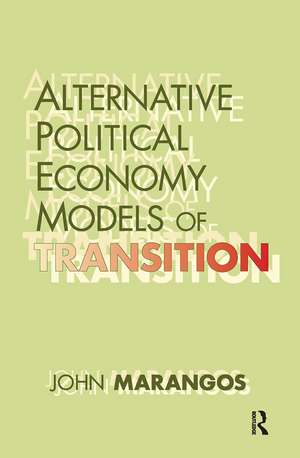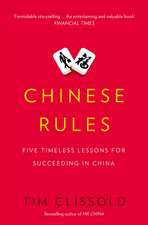Alternative Political Economy Models of Transition: The Russian and East European Perspective
Editat de John Marangosen Limba Engleză Hardback – 18 sep 2018
The volume develops transition models from what Marangos defines as the primary elements of six variables: (1) economic analysis; (2) definitions of the Good Society; (3) speed of transition; (4) political structure; (5) ideological structure; and (6) initial conditions. The models developed include: the shock therapy model, the neoclassical gradualist model of transition, the post Keynesian model, the pluralistic market, the socialist model, and the non-pluralistic market socialist model. After identifying the primary elements of each transition model, Marangos considers the elements of each model with respect to the desirable reforms.
An essential element of the transition process is not only to identify the necessary reforms but also a sequence in which the reforms should be introduced. For each transition model developed in this book, a set of primary and secondary elements were provided in conjunction with a sequence of reforms. Analyzing the transition problem from a political economy perspective, Marangos shows that it is possible to have inconsistencies within each transition model and between transition models yet be able to identify the potential for implementation and maintenance of necessary reforms each model recommends. This volume contributes to the understanding of the process of transition, with the objective of identifying an optimal model of transition.
| Toate formatele și edițiile | Preț | Express |
|---|---|---|
| Paperback (1) | 281.89 lei 6-8 săpt. | |
| Taylor & Francis – 15 ian 2008 | 281.89 lei 6-8 săpt. | |
| Hardback (1) | 669.94 lei 6-8 săpt. | |
| Taylor & Francis – 18 sep 2018 | 669.94 lei 6-8 săpt. |
Preț: 669.94 lei
Preț vechi: 788.16 lei
-15% Nou
Puncte Express: 1005
Preț estimativ în valută:
128.19€ • 133.84$ • 106.10£
128.19€ • 133.84$ • 106.10£
Carte tipărită la comandă
Livrare economică 04-18 aprilie
Preluare comenzi: 021 569.72.76
Specificații
ISBN-13: 9781138380783
ISBN-10: 1138380784
Pagini: 330
Dimensiuni: 152 x 229 mm
Greutate: 0.45 kg
Ediția:1
Editura: Taylor & Francis
Colecția Routledge
Locul publicării:Oxford, United Kingdom
ISBN-10: 1138380784
Pagini: 330
Dimensiuni: 152 x 229 mm
Greutate: 0.45 kg
Ediția:1
Editura: Taylor & Francis
Colecția Routledge
Locul publicării:Oxford, United Kingdom
Cuprins
List of Figures and Tables
Foreword
Acknowledgements
Introduction to the Transaction Edition
PART I: Comparative Models of Transition
Chapter 1 The Collapse of the Stalinist Economic System
Chapter 2 The Analytical Framework
Chapter 3 The Cost of Transition
PART II: Case Studies in Transition Economies
Chapter 4 The Shock Therapy Model of Transition
Chapter 5 The Neoclassical Gradualist Model of Transition
Preventive Therapy
Chapter 6 The Post Keynesian Model of Transition:
Developing a Civilized Society
Chapter 7 The Pluralistic Market Socialist Model of Transition
Chapter 8 The Non-Pluralistic Model of Market Socialism:
The Chinese Approach
PART III: Conclusions
Chapter 9 Was There an Optimal Model of Transition?
Appendix
Bibliography
Index
Foreword
Acknowledgements
Introduction to the Transaction Edition
PART I: Comparative Models of Transition
Chapter 1 The Collapse of the Stalinist Economic System
Chapter 2 The Analytical Framework
Chapter 3 The Cost of Transition
PART II: Case Studies in Transition Economies
Chapter 4 The Shock Therapy Model of Transition
Chapter 5 The Neoclassical Gradualist Model of Transition
Preventive Therapy
Chapter 6 The Post Keynesian Model of Transition:
Developing a Civilized Society
Chapter 7 The Pluralistic Market Socialist Model of Transition
Chapter 8 The Non-Pluralistic Model of Market Socialism:
The Chinese Approach
PART III: Conclusions
Chapter 9 Was There an Optimal Model of Transition?
Appendix
Bibliography
Index
Notă biografică
John Marangos is associate professor in the department of economics at Colorado State University. He is the editor of the Forum of Social Economics and section editor of International Economics and Development Studies for the Global Business and Economic Review. He is also a member of the editorial board of the Journal of Economic Issues.
Descriere
The collapse of centrally administered socialism in Russia and Eastern Europe resulted in what is commonly referred to as the transition problem: the transformation from a centrally administered socialist economic system to one that is market-based. Economic science has been faced with the challenge of developing an appropriate body of analysis, advice, and direction to help other nations that may be undergoing this process. In this volume, John Marangos adopts a political economy approach that yields alternative models of transition.The volume develops transition models from what Marangos defines as the primary elements of six variables: (1) economic analysis; (2) definitions of the Good Society; (3) speed of transition; (4) political structure; (5) ideological structure; and (6) initial conditions. The models developed include: the shock therapy model, the neoclassical gradualist model of transition, the post Keynesian model, the pluralistic market, the socialist model, and the non-pluralistic market socialist model. After identifying the primary elements of each transition model, Marangos considers the elements of each model with respect to the desirable reforms.An essential element of the transition process is not only to identify the necessary reforms but also a sequence in which the reforms should be introduced. For each transition model developed in this book, a set of primary and secondary elements were provided in conjunction with a sequence of reforms. Analyzing the transition problem from a political economy perspective, Marangos shows that it is possible to have inconsistencies within each transition model and between transition models yet be able to identify the potential for implementation and maintenance of necessary reforms each model recommends. This volume contributes to the understanding of the process of transition, with the objective of identifying an optimal model of transition.











